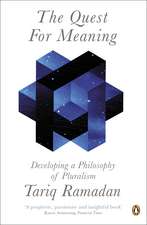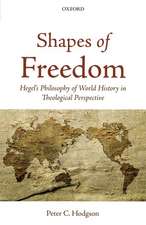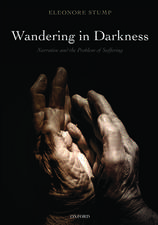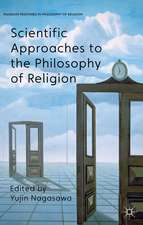Religious Pluralism: Framing Religious Diversity in the Contemporary World
Editat de Giuseppe Giordan, Enzo Paceen Limba Engleză Paperback – 3 sep 2016
The book starts by first detailing general issues related to religious pluralism. It makes the case for keeping the empirical, the normative, the regulatory and the interactive dimensions of religious pluralism analytically distinct while recognizing that, in practice, they often overlap. It also underlines the importance of seeking connections between religious pluralism and other pluralisms. Next, the book explores how religious diversity can operate to contribute to legal pluralism and examines the different types of church-state relations: eradication, monopoly, oligopoly and pluralism.
The second half of the book features case studies that provide a more specific look at the general issues, from ways to map and assess the religious diversity of a whole country to a comparison between Belgian-French views of religious and philosophical diversity, from religious pluralism in Italy to the shifting approach to ethnic and religious diversity in America, and from a sociological and historical perspective of religious plurality in Japan to an exploration of Brazilian religions, old and new.
The transition from religious diversity to religious pluralism is one of the most important challenges that will reshape the role of religion in contemporary society. This book provides readers with insights that will help them better understand and interpret this unprecedented transition.
| Toate formatele și edițiile | Preț | Express |
|---|---|---|
| Paperback (1) | 635.65 lei 6-8 săpt. | |
| Springer International Publishing – 3 sep 2016 | 635.65 lei 6-8 săpt. | |
| Hardback (1) | 641.85 lei 6-8 săpt. | |
| Springer International Publishing – 29 iul 2014 | 641.85 lei 6-8 săpt. |
Preț: 635.65 lei
Preț vechi: 747.82 lei
-15% Nou
Puncte Express: 953
Preț estimativ în valută:
121.67€ • 132.21$ • 102.27£
121.67€ • 132.21$ • 102.27£
Carte tipărită la comandă
Livrare economică 21 aprilie-05 mai
Preluare comenzi: 021 569.72.76
Specificații
ISBN-13: 9783319381879
ISBN-10: 3319381873
Pagini: 198
Ilustrații: X, 188 p. 14 illus.
Dimensiuni: 155 x 235 x 11 mm
Greutate: 0.29 kg
Ediția:Softcover reprint of the original 1st ed. 2014
Editura: Springer International Publishing
Colecția Springer
Locul publicării:Cham, Switzerland
ISBN-10: 3319381873
Pagini: 198
Ilustrații: X, 188 p. 14 illus.
Dimensiuni: 155 x 235 x 11 mm
Greutate: 0.29 kg
Ediția:Softcover reprint of the original 1st ed. 2014
Editura: Springer International Publishing
Colecția Springer
Locul publicării:Cham, Switzerland
Cuprins
Chapter 1: Introduction: Pluralism as Legitimization of Diversity; Giuseppe Giordan.- PART I: IDEAS AND CONCEPTS ON RELIGIOUS PLURALISM.- Chapter 2: Rethinking Religious Pluralism; James A. Beckford.- Chapter 3: Religious Diversity, Social Control and Legal Pluralism: A Socio-Legal Analysis; James T. Richardson.- Chapter 4: Oligopoly Is Not Pluralism; Fenggang Yang.- PART II: CASE STUDIES IN RELIGIOUS PLURALISM.- Chapter 5 : Religious and Philosophical Diversity as a Challenge for the Secularism: A Belgian-French Comparison; Jean-Paul Willaime.- Chapter 6: The Diversity of Religious Diversity. Using Census and NCS Methodology in Order to Map and Assess the Religious Diversity of a Whole Country; Christophe Monnot and Jörg Stolz.- Chapter 7: Increasing Religious Diversity in a Society Monopolized by Catholicism; Vincenzo Pace.- Chapter 8: Rethinking Religious Diversity: Diversities and Governance of Diversities in “Post-Societies”; Siniša Zrinščak.- Chapter 9: Diversity vs Pluralism? Notes from the American Experience; James V. Spickard.- Chapter 10: Between No Establishment and Free Exercise: The Dialectic of American Religious Pluralism; William H. Swatos, Jr.- Chapter 11: Missionary Trans-border Religions and Defensive Civil Society in Contemporary Japan: Toward a Comparative Institutional Approach to Religious Pluralism; Yoshihide Sakurai.- Chapter 12: Religious Tendencies in Brazil: Disenchantment, Secularization and Sociologists; Roberto Motta.- Index.
Notă biografică
Giuseppe Giordan is Senior Lecturer in Sociology at the University of Padua. From 2009 to 2013 he served as General Secretary of the International Society for the Sociology of Religion. With Enzo Pace and Luigi Berzano he edits the Annual Review of the Sociology of Religion. His books in English include Identity and Pluralism. The Values of the Post-Modern Time. Center for Migration Studies, 2004; Vocation and Social Context (ed.), Brill, 2007; Conversion in the Age of Pluralism (ed.), Brill, 2009; Youth and Religion (ed.), Brill, 2010; Religion, Spirituality and Everyday Practices (ed. with William H. Swatos, Jr.) Springer, 2011.
Enzo Pace, Full professor of sociology of religion at Padua University, Directeur d’Études invité at the École des Hautes Études en Sciences Sociales, Past-President of the International Society for the Sociology of Religion (ISSR). Co-editors of the Annual Review of the Sociology of Religion (Brill). Recent publications: Religion as Communication. Farnham: Ashgate, 2011; Il carisma, la fede, la chiesa: introduzione alla sociologia del cristianesimo. Roma: Carocci, 2012; La comunicazione invisibile. Religioni e internet. Cinisello Balsamo, San Paolo Editore, 2013.
Enzo Pace, Full professor of sociology of religion at Padua University, Directeur d’Études invité at the École des Hautes Études en Sciences Sociales, Past-President of the International Society for the Sociology of Religion (ISSR). Co-editors of the Annual Review of the Sociology of Religion (Brill). Recent publications: Religion as Communication. Farnham: Ashgate, 2011; Il carisma, la fede, la chiesa: introduzione alla sociologia del cristianesimo. Roma: Carocci, 2012; La comunicazione invisibile. Religioni e internet. Cinisello Balsamo, San Paolo Editore, 2013.
Textul de pe ultima copertă
This volume illustrates both theoretically and empirically the differences between religious diversity and religious pluralism. It highlights how the factual situation of cultural and religious diversity may lead to individual, social and political choices of organized and recognized pluralism. In the process, both individual and collective identities are redefined, incessantly moving along the continuum that ranges from exclusion to inclusion.
The book starts by first detailing general issues related to religious pluralism. It makes the case for keeping the empirical, the normative, the regulatory and the interactive dimensions of religious pluralism analytically distinct while recognizing that, in practice, they often overlap. It also underlines the importance of seeking connections between religious pluralism and other pluralisms. Next, the book explores how religious diversity can operate to contribute to legal pluralism and examines the different types of church-state relations: eradication, monopoly, oligopoly and pluralism.
The second half of the book features case studies that provide a more specific look at the general issues, from ways to map and assess the religious diversity of a whole country to a comparison between Belgian-French views of religious and philosophical diversity, from religious pluralism in Italy to the shifting approach to ethnic and religious diversity in America, and from a sociological and historical perspective of religious plurality in Japan to an exploration of Brazilian religions, old and new.
The transition from religious diversity to religious pluralism is one of the most important challenges that will reshape the role of religion in contemporary society. This book provides readers with insights that will help them better understand and interpret this unprecedented transition.
The book starts by first detailing general issues related to religious pluralism. It makes the case for keeping the empirical, the normative, the regulatory and the interactive dimensions of religious pluralism analytically distinct while recognizing that, in practice, they often overlap. It also underlines the importance of seeking connections between religious pluralism and other pluralisms. Next, the book explores how religious diversity can operate to contribute to legal pluralism and examines the different types of church-state relations: eradication, monopoly, oligopoly and pluralism.
The second half of the book features case studies that provide a more specific look at the general issues, from ways to map and assess the religious diversity of a whole country to a comparison between Belgian-French views of religious and philosophical diversity, from religious pluralism in Italy to the shifting approach to ethnic and religious diversity in America, and from a sociological and historical perspective of religious plurality in Japan to an exploration of Brazilian religions, old and new.
The transition from religious diversity to religious pluralism is one of the most important challenges that will reshape the role of religion in contemporary society. This book provides readers with insights that will help them better understand and interpret this unprecedented transition.
Caracteristici
Illustrates both theoretically and empirically the differences between religious diversity and religious pluralism Highlights how the factual situation of cultural and religious diversity may lead to individual, social and political choices of organized and recognized pluralism Details general issues related to religious pluralism and features case studies that provide a more specific look at these issues
















